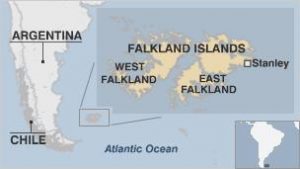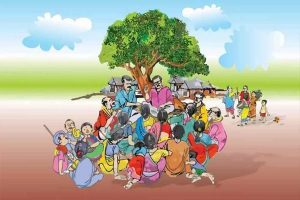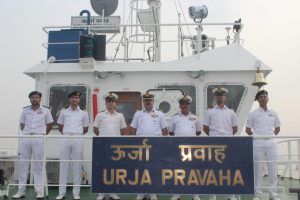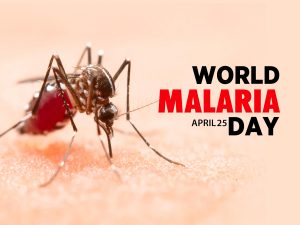Today Current Affairs: 26th April 2022 for UPSC IAS exams, State PSC exams, SSC CGL, State SSC, RRB, Railways, Banking Exam & IBPS, etc
Table of Contents
Arunachal Pradesh – Assam Border Dispute:

Arunachal Pradesh Chief Minister Pema Khandu and his Assam counterpart Himanta Biswa Sarma have decided to form district-level committees for settling their inter-state boundary disputes.
- Recently, the Union government gave the seal of approval to an agreement to partially resolve the disputed sectors on the Assam-Meghalaya border.
- Assam has had boundary disputes with all the north-eastern States that were carved out of it.
- Arunachal Pradesh and Mizoram were separated from Assam as Union Territories in 1972 and as States in 1987.
- None of the new States accepted the “constitutional boundary” that they said was dictated by the partisan administration of undivided Assam without consulting the tribal stakeholders.
- The issue with Arunachal Pradesh has more to do with a 1951 report prepared by a sub-committee headed by Assam’s first Chief Minister, Gopinath Bordoloi.
- Arunachal Pradesh and Assam have disputes at about 1,200 points along their 804 km boundary.
- The apex court appointed a local boundary commission in 2006 headed by one of its retired judges.
- In its September 2014 report, this commission recommended that Arunachal Pradesh should get back some of the areas transferred in 1951 besides advising both the States to find a middle path through discussions.
Household Consumer Spending Survey:

The All-India Household Consumer Expenditure Survey is usually conducted by the National Statistical Office (NSO) every five years.
- It is designed to collect information on the consumption spending patterns of households across the country, both urban and rural.
- The data gathered in this exercise reveals the average expenditure on goods (food and non-food) and services.
- It is set to resume this year after a prolonged break.
- It is used to arrive at estimates of poverty levels in different parts of the country and to review economic indicators like the Gross Domestic Product (GDP).
- India hasn’t had any official estimates on per capita household spending since 2011–12.
NSO:
- The government has formed an overarching body NSO by merging the National Sample Survey Office (NSSO), Computer Centre and Central Statistical Office (CSO).
- NSO was first envisaged by Rangarajan Commission to implement and maintain statistical standards and coordinate statistical activities of Central and State agencies as laid down by the National Statistical Commission (NSC).
- Parent Ministry: It is the statistical wing of the Ministry of Statistics and Programme Implementation (MoSPI).
- It Compiles and releases the Index of Industrial Production (IIP) every month in the form of ‘quick estimates’ and conducts the Annual Survey of Industries (ASI).
What Are Invasive Species?

Senna spectabilis is an invasive species found mostly in the forest areas of the Nilgiri Biosphere Reserve (NBR).
- The dearth of effective steps to arrest the rampant growth of these invasive plants is a matter of serious concern to the conservation of wildlife habitats of the Western Ghats.
- The invasive species has now spread through the most iconic wildlife habitats of the Western Ghats, destroying habitats of elephants, deer, gaur and tigers by pushing out native flora.
- The allelopathic traits of the species prevent other plants from growing under it. Allelopathy is a biological phenomenon by which an organism produces one or more biochemicals that influence the germination, growth, survival, and reproduction of other organisms.
- This drastically affects primary productivity at the ground level.
- The forest floor is almost bare under the invasive species. Grasses and herbs get completely wiped out and herbivores are deprived of their forage.
- The carrying capacity of forests to feed wildlife is drastically declining under the invasion, which accelerates man-animal conflict further.
- The Kerala Forest Department attempted to remove the trees by uprooting, girdling, cutting, chopping the tree branches, and even testing the application of chemicals. However, all the efforts were in vain. Instead, multiple coppice shoots started growing from each cut tree stump. The situation is similar in the Karnataka and Tamil Nadu.
Invasive species:
- Invasive alien species are plants, animals, pathogens and other organisms that are non-native to an ecosystem, and which may cause economic or environmental harm or adversely affect human health.
- In particular, they impact adversely upon biodiversity, including decline or elimination of native species – through competition, predation, or transmission of pathogens – and the disruption of local ecosystems and ecosystem functions.
Falklands Dispute:

“The Commission for Dialogue” with the United Kingdom on the Falkland Islands was recently inaugurated by India and Argentina.
- The commission seeks to settle the territorial dispute over the Islas Malvinas that are known as the Falkland Islands in the UK.
- The British, in 1765, were the first to settle West Falkland, but they were driven off in 1770 by the Spanish.
- The British outpost on West Falkland was restored in 1771 after threat of war, but then the British withdrew from the island in 1774 for economic reasons, without renouncing their claim to the Falklands.
- Spain maintained a settlement on East Falkland (which it called Soledad Island) until 1811.
- In 1820 the Argentina Government, which had declared its independence from Spain in 1816, proclaimed its sovereignty over the Falklands.
- However, in 1841, a British civilian lieutenant governor was appointed for the Falklands.
- In February 1982, Argentina’s military government invaded the Falklands. This act started the Falkland Islands War.
- The war ended with the surrender of the Argentine forces at Stanley to British troops who had forcibly reoccupied the islands.
- In a referendum held in March 2013, islanders voted nearly unanimously to remain a British overseas territory.
- Despite wars and discussions at the United Nations, the issue of sovereignty remains a point of contention.
Location:
Falkland islands are an overseas territory of the United Kingdom located to the southwest Atlantic Ocean at the southernmost point of South America.
Positioned both in the southern and western hemispheres of the Earth.
They are also called Malvinas Islands.
Blue Straggler Stars:

Scientists at Indian Institute of Astrophysics, Bengaluru, have found support for one way to understand peculiarity about Blue Straggler Star.
- The researchers made use of the observations by the UVIT instrument (Ultraviolet Imaging Telescope) of Astrosat, India’s first science observatory in space.
- Earlier in September 2021, in the first-ever comprehensive analysis of blue stragglers, Indian researchers had proposed a hypothesis for the evolution of blue straggler stars.
- Blue Straggler Star are hot, blue, massive stars and seem to have a different trajectory of evolution from the norm.
- There are a few stars that, when they are expected to start expanding in size and cooling down, do just the opposite.
- They grow brighter and hotter as indicated by their blue color.
- Thus, standing out from the cooler red stars in their vicinity in the color-magnitude diagram.
- Since they lag their peers in evolution, they are called stragglers, more specifically, blue stragglers, because of their hot, blue color.
- Allan Sandage (an astronomer with Carnegie Observatories in Pasadena, California) discovered blue stragglers in the globular cluster M3 in 1952-53.
- Most are located at least several thousand light-years away from the sun, and most are around 12 billion years old or more.
- The Milky Way’s largest and brightest globular is Omega Centauri.
What Is Seafloor Spreading?

According to a study that analyzed data from the last 19 million years, Seafloor spreading rates have slowed down by roughly 35% globally.
- For this study, researchers selected 18 of the world’s largest spreading ridges (mid-ocean ridges).
- A ridge or a mountain ridge is a geographical feature consisting of a chain of mountains or hills that form a continuous elevated crest for an extended distance.
- By studying magnetic records in the rocks on the oceanic crust, they calculated how much oceanic crust had formed over the last 19 million years.
- Basalt rocks on the oceanic crust contain magnetic properties.
- Their magnetism is influenced by the Earth’s magnetic field when the magma reaches the surface and begins cooling to form the crust.
- But the records are incomplete because the crusts get destroyed at subduction zones.
- Subduction zone is a point where two tectonic plates collide, causing one of them to sink into the Earth’s mantle beneath the other plate.
- The seafloor spreading hypothesis was proposed by the American geophysicist Harry H. Hess in 1960.
- Seafloor spreading is the process of magma welling up in the rift as the old crust pulls itself in opposite directions.
- Cold seawater cools the magma, creating a new crust.
- The upward movement and eventual cooling of this magma has created high ridges on the ocean floor over millions of years.
- However, the seafloor is destroyed in subduction zones, where oceanic crust slides under continents and sinks back into the mantle, and is reforged at seafloor spreading ridges.
- The East Pacific Rise is a site of major seafloor spreading in the Ring of Fire.
- It is located on the divergent boundary of the Pacific Plate, the Cocos Plate (west of Central America), the Nazca Plate (west of South America), the North-American Plate and the Antarctic Plate.
What Is Vertical Farming?

India is evolving every day with something new. Also, industrialization is increasing dramatically due to which many arable lands are at greater risk. Vertical farming in India is the answer to all these problems.
- The modern concept was first proposed in 1999 by professor Dickson Despommier. His concept centered on the idea that urban areas should grow their own food which can save time and resources required for transportation.
- Instead of horizontally on the ground like traditional farming, vertical farming grows crops in vertical, stacked layers without putting too much impact on land and water resources which are scarce.
- It includes soilless farming techniques, among others.
- Vertical farming systems like aeroponics and hydroponics come under the broad umbrella ambit of ‘protected cultivation’, where one can control and regulate multiple variables like water, soil, temperature, humidity, and so on.
- Protected cultivation, when practised at scale, offers a massive potential to shorten and optimise our farm-to-plate supply chains by making food available closer to the consumer and thereby can go a long way to improve our nation’s GDP (Gross Domestic Product) and reduce imports dependency.
- Types:
- Hydroponics: Hydroponics is a method of growing plants in a water-based, nutrient-rich solution.
- In this method, the root system is supported using an inert medium such as perlite, clay pellets, peat moss or vermiculite.
- The main purpose is to provide access to oxygen which is essential for proper growth.
- Aeroponics: Aeroponics is an environment-friendly way of farming in which the roots are suspended in the air and plants grow in a humid environment without soil.
- Aquaponics: Aquaponics is a system that combines hydroponics and aquaculture within a closed system.
- There are three biological components in the aquaponics process: fishes, plants, and bacteria.
- Hydroponics: Hydroponics is a method of growing plants in a water-based, nutrient-rich solution.
Anti-Defection Law:

The Vice-President has said that the time has come to amend the anti-defection legislation in the country to plug existing loopholes.
- The anti-defection law punishes individual Members of Parliament (MPs)/MLAs for leaving one party for another.
- Parliament added it to the Constitution as the Tenth Schedule in 1985. Its purpose was to bring stability to governments by discouraging legislators from changing parties.
- The Tenth Schedule – popularly known as the Anti-Defection Act – was included in the Constitution via the 52nd Amendment Act, 1985.
- It sets the provisions for disqualification of elected members on the grounds of defection to another political party.
- It was a response to the toppling of multiple state governments by party-hopping MLAs after the general elections of 1967.
- However, it allows a group of MP/MLAs to join (i.e., merge with) another political party without inviting the penalty for defection.
- And it does not penalize political parties for encouraging or accepting defecting legislators.
- As per the 1985 Act, a ‘defection’ by one-third of the elected members of a political party was considered a ‘merger’.
- But the 91st Constitutional Amendment Act, 2003, changed this and now at least two-thirds of the members of a party must be in Favour of a “merger” for it to have validity in the eyes of the law.
- The members disqualified under the law can stand for elections from any political party for a seat in the same House.
- The decision on questions as to disqualification on ground of defection are referred to the Chairman or the Speaker of such House, which is subject to ‘Judicial review’.
- However, the law does not provide a timeframe within which the presiding officer has to decide a defection case.
National Panchayati Raj Day 2022:

India commemorates the 12th National Panchayati Raj day on 24th April 2022.
- The Prime Minister has launched the distribution of e-property cards under the SWAMITVA (Survey of Villages and Mapping with Improvised Technology in Village Areas) scheme on the Day.
- The first National Panchayati Raj Day was celebrated in 2010. Since then, the National Panchayati Raj Day is celebrated on 24th April every year in India.
- The day marks the enactment of the 73rd amendment of the constitution in 1992.
The Ministry of Panchayati Raj has been awarding the best performing Panchayats/States/UTs across the country in recognition of their good work. - Awards are given under various categories namely,
- Deen Dayal Upadhyay Panchayat Sashaktikaran Puraskar,
- Nanaji Deshmukh Rashtriya Gaurav Gram Sabha Puraskar,
- Child-friendly Gram Panchayat Award,
- Gram Panchayat Development Plan Award and
- e-Panchayat Puraskar (given to States/UTs only).
Palli village in Jammu’s Samba district has become the country’s first panchayat to become carbon neutral, fully powered by solar energy and with all its records digitised and saturation of benefits of all the Central schemes.
Indian Coast Guard Ship Urja Pravaha:

Urja Pravaha, the Indian Coast Guard Ship (Auxiliary Barge) has been inducted into the Indian Coast Guard at Bharuch, Gujarat.
- Urja Pravaha arrived in Kochi on 22ND April 2022 and it will be under the Coast Guard District Headquarters-4’s (Mahe and Kerala) operational command.
- The auxiliary barge Urja Shrota has also been based here since 2017.
- Urja Pravaha has a draft of 1.85 meters and it is 36.96 meter long.
- It has been designed to cargo aviation fuel, ship fuel, and freshwater with a capacity limit of 10 tons, 50 tons, and 40 tons respectively.
- This newly inducted ship will help in enhancing the operations of the Indian Coast Guard (ICG) by extending logistics support to the ships of the Coast Guard that have been deployed in the sea at far-flung areas to conduct various charter of duties.
- The induction of the Urja Pravaha will also be optimizing the operational capability of the Indian Coast Guard.
- An Auxiliary Barge is a Naval ship that has been designed with the purpose of operating in support of all the combatant ships.
‘Kisan Bhagidari, Prathmikta Hamari’ Campaign:

The ‘Kisan Bhagidari, Prathmikta Hamari’ campaign is being organized from 25th April 2022 by the Ministry of Agriculture and Farmers Welfare.
- This campaign will continue till 30th April 2022 and is being organized under the government’s ‘Azadi Ka Amrit Mahotsav’ in collaboration with various other Departments and Ministries.
- During the period of this campaign, various countrywide programs at the regional level for the farmers of the nation are being organized by the Department of Agriculture and Farmers Welfare.
- Under this campaign, a National Atma Nirbhar Bharat Conclave of 75 selected entrepreneurs and farmers will be conducted.
- Also, during this campaign the milestones reached in the field of agriculture development in the country’s 75 years of Independence including the Green Revolution and self-sufficiency in the production of food grain will be highlighted.
- Over one crore stakeholders and farmers will be participating in the ‘Kisan Bhagidari, Prathmikta Hamari’ campaign.
World Malaria Day 2022:

Annually on the 25th of April World Malaria Day is observed across the world to highlight the need for sustained political commitment and continued investment so as to prevent and control malaria across the world.
- The World Health Organization has continuously highlighted the need for and also called for innovations and investments to bring in new vector control approaches, antimalarial medicines, diagnostics, and other tools that will help in fighting against malaria.
- The theme of World Malaria Day 2022 :The theme for this year’s world malaria day is “Harness innovation to reduce the malaria disease burden and save lives.”
- The day is significant as despite being a treatable disease, Malaria continues to impact the livelihoods of people all over the world.
- According to the WHO, in the year 2020 around 241 million new cases of malaria and 6,27,000 fatalities due to malaria in 85 nations were witnessed.
- In the African region, more than two-thirds of the reported fatalities were among children who were below the age of 5.
- This data shows that in spite of achieving steady advances against malaria from 2000 to 2015, there has been a slowdown in recent years, especially in the countries of Sub-Saharan Africa.
Carbon Tax:

Dozens of nations and many local governments are putting a price tag on greenhouse gas emissions that are increasing flooding, droughts and other costly catastrophes.
- Pennsylvania becomes the first major fossil fuel-producing state in the US to adopt a carbon pricing policy to address climate change.
- It joins 11 states where coal, oil and natural gas power plants must buy credits for every ton of carbon dioxide they emit.
- President Joe Biden is attempting a less direct approach — known as the social cost of carbon — that calculates future climate damages to justify tougher restrictions on polluting industries.
- Governments elsewhere have moved more aggressively. Canada, for example, imposes fuel charges on individuals and also makes big polluters pay for emissions.
- It’s one of 27 nations with some kind of carbon tax, according to The World Bank.
- The social cost of carbon attempts to capture the value of all climate damage, centuries into the future.
- Carbon pricing reflects how much companies are willing to pay today for a limited amount of emission credits offered at auction.
- In other words, the social cost of carbon guides policy, while carbon pricing represents policy in practice.
Raisina Dialogue:

Prime Minister Narendra Modi inaugurated the seventh edition of Raisina Dialogue on April 25, 2022.
- President of the European Union Ursula Von Der Leyen is the chief guest at the Dialogue.
- The three-day Dialogue is based on the theme – Terranova, impassioned, impatient, imperiled.
- There are six broad thematic pillars of the Dialogue including Rethinking Democracy, End of Multilateralism, Water Caucuses, and Achieving Green Transitions.
- Raisina Dialogue will have around 100 sessions with over 210 speakers from 90 countries.
- The Raisina Dialogue is a multilateral conference committed to addressing the most challenging issues facing the global community.
- Every year, global leaders in policy, business, media, and civil society are hosted in New Delhi to discuss cooperation on a wide range of pertinent international policy matters.
- The conference is hosted by the Observer Research Foundation in collaboration with the Ministry of External Affairs.




